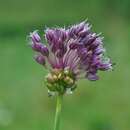en
names in breadcrumbs


The sand leek (Allium scorodoprasum), also known as rocambole and Korean pickled-peel garlic,[4] is a Eurasian species of wild onion with a native range extending across much of Europe, Middle East, and Korea.[3][5][6][7][8][9] The species should not be confused with rocambole garlic, which is A. sativum var. ophioscorodon.
The sand leek is a perennial plant with an egg-shaped bulb. The plant produces two to five unstalked leaves, the bases of which are sheath-like. Each leaf blade is linear, 7–20 mm wide,[10] flat with a slight keel, an entire margin and parallel veins. The edges of the leaf and the central vein are rough to the touch. The flowering stem is cylindrical, growing to a height of 30 to 90 cm (12 to 35 in) and the upper half is leafless. The whole plant has an onion-like aroma. The inflorescence is a globular cluster surrounded by membranous bracts in bud which wither when the flowers open. Each individual flower is stalked and has a purple perianth 4 to 7 mm (0.16 to 0.28 in) long. There are six tepals, six stamens and a pistil formed from three fused carpels. Mixed with the flowers are a number of purple bulbils. The fruit is a capsule, but the seeds seldom set, and propagation usually takes place when the bulbils are knocked off and grow into new plants.[11]
The natural habitat of A. scorodoprasum is damp broad-leaved woodland, forest margins, shores, hillside meadows and hedgerows. It was at one time used as a kitchen herb and can sometimes be found near old habitations.[11][12]
A. scorodoprasum is edible but seldom cultivated, and has a shorter flower stalk and fewer and more inconsistently shaped cloves than Rocambole garlic. Sand leek also has a dark violet bulb wrapper.[13]
Elephant garlic (properly A. ampeloprasum var. ampeloprasum) is also sometimes incorrectly sold as A. scorodoprasum.
The sand leek (Allium scorodoprasum), also known as rocambole and Korean pickled-peel garlic, is a Eurasian species of wild onion with a native range extending across much of Europe, Middle East, and Korea. The species should not be confused with rocambole garlic, which is A. sativum var. ophioscorodon.